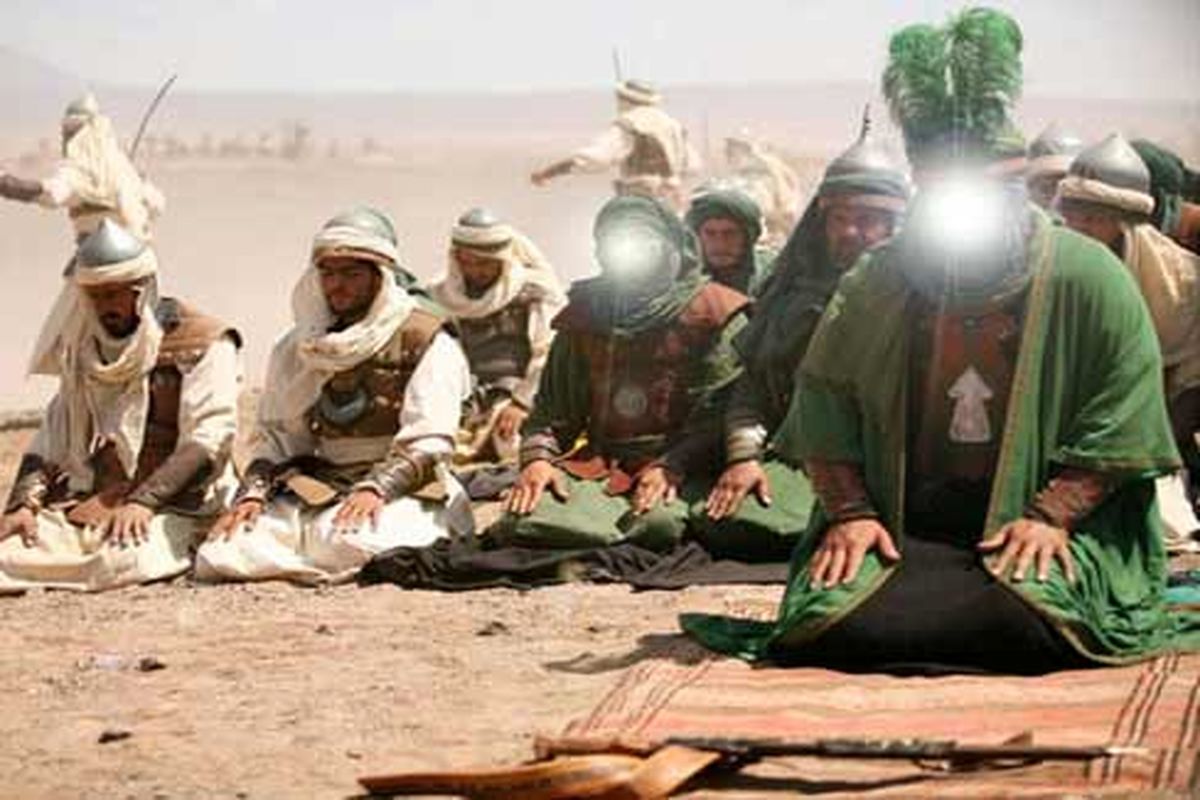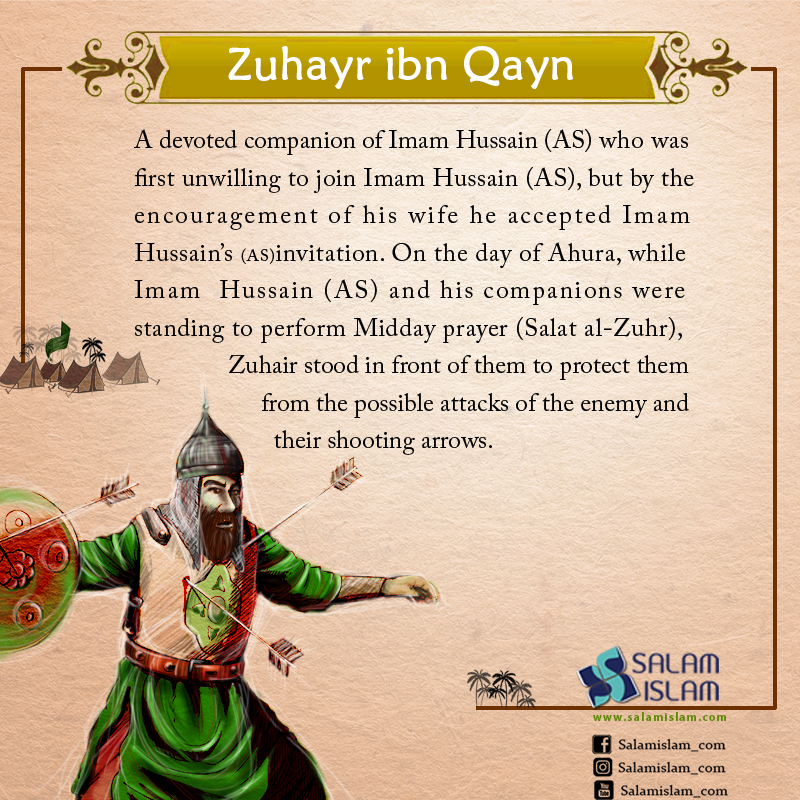

The characteristics of Imam Hussain 's (AS) companions
When discussing the companions of Imam Hussain (AS), the most significant aspect to consider is their actions and decisions in specific circumstances where they had to make choices. While reading history, it might seem ordinary to us that when faced with oppression and injustice, any rational human being would stand against it. However, before making decisions, people need to be sure if their resistance is worthwhile.
Throughout history, many people fought and died for what they believed to be the truth, only to find out they were supporting evil.
In this text, we will delve into some of the most astonishing characteristics of the companions of Imam Hussain (AS) that made them so special in history.
Obedience
The outcome of faith is guidance:
“Whoever has faith in Allah, He guides his heart.” (64: 11)
However, this guidance is achievable through obedience:
“O you who have faith! Obey Allah and obey the Apostle and those vested with authority among you.” (4: 59)
The most vital trait of the companions of Imam Hussain (AS) was their faith and reliance on Allah, and their obedience to Him, His messenger, and their leader - Imam Hussain (AS).
On the night of Ashura, Imam Hussain (AS) gathered his companions and said “I release you from the allegiance and oath you’ve taken from me. The darkness of the night surrounds you, so break free from the turmoil hidden in the darkness waves. Then each of you may hold of the hand of my family members and disperse into the villages and cities until Allah grants you relief .” The companions, one by one, replied “By Allah! We shall not abandon you. In fact, we are ready to sacrifice our lives for yours. We shall defend you with our necks, faces and hands. We will fulfill our duty even if it costs our lives.” [1]

Distinguishing right from wrong
The situation in the year 61 AH during the battle of Karbala was perplexing. People had to differentiate between the truth among two groups both claiming to fight for Islam. Imam Hussain (AS) left Medina as he knew Yazid, the son and the successor of the late caliph, disregarded Islamic principles. However, since Yazid and his ministers presented themselves with an Islamic facade, it was challenging for ordinary people to discern the correct side. Consequently, most Muslims were deceived by their hypocritical behavior, or they were threatened by Yazid’s ministers due to fears of losing material gains, causing them to join Yazid’s army.
It this context, Yazid managed to amass of over thirty thousand soldiers, while only few individuals - less than a hundred – chose to stand with Imam Hussain (AS). This fact highlights the great wisdom and bravery of Imam Hussain’s (AS) companions, and this wisdom, as the Quran mentioned, arises from steadfast faith:
“O you who have faith! If you are wary of Allah, He shall appoint a criterion for you, and absolve you of your misdeeds...” (8:29)
The Arabic term translated as “criterion” in the above verse is Furqan. Furqan is the power to distinguish right from wrong, a type of wisdom and insight bestowed by Allah upon His pious servants, which is not dependent on knowledge, literacy, or information. [1]
Based on this criterion granted by Almighty Allah, the companions of Imam Hussain (AS), coming from diverse ages and social, cultural and religious backgrounds, were all able to differentiate between right from wrong. It is regrettable that only a few comprehend this distinction!
“… But most of them do not know the truth, and so they are disregardful.” (21: 24)
Detachment from the world
Even among the faithful, some chose not to oppose Imam Hussain (AS) in the battle of Karbala. They remained silent and withheld their support for the Imam. The status of these believers differs from those who sacrificed their possessions and lives for the sake of Allah (SWT). Allah says in the
Quran:
“Not equal are those of the faithful who sit back—excepting those who suffer from some disability—and those who wage jihad in the way of Allah with their possession and their persons. Allah has graced those who wage jihad with their possessions and their persons by a degree over those who sit back…” (4: 95)
Loving Allah (SWT) and Being Loved by Allah (SWT)
Allah describes the relationship between Him and His pious servants as a mutual bond of love, with Allah (SWT) being the first to express love. In a beautiful Quranic verse Allah portrays His faithful, courageous, and humble servants as individuals loved by Him:
“O you who have faith! Should any of you desert his religion, Allah will soon bring a people whom He loves and who love Him, [who will be] humble towards the faithful, stern towards the faithless, waging jihad in the way of Allah, not fearing the blame of any blamer. That is Allah’s grace, which He grants to whomever He wishes, and Allah is all-bounteous, all-knowing.” (5: 54)
This verse underscores that these individuals may face criticism and blame from due to their decisions, but it will not make them turn away from their spiritual path.
Sacrifice
Another important characteristic of Imam Hussain’s (AS) companions was their selfless sacrifice in upholding the religion and tradition of the Prophet (PBUH&HP). It takes a noble soul to make sacrifices for others, and even more so when sacrificing one’s life to preserve the religion of Allah (SWT). This is why in the loving relationship that the companions of Imam had with their Lord, they presented their body and soul in defending the truth.
“And among the people is he who sells his soul seeking the pleasure of Allah, and Allah is most kind to [His] servants.” (2:207)
References:
- Qummi, A. Nafassul Mahmoum
- Qara’ati, M. Tafseer-e Nour, vol. 3, p. 305
Share This Article

What Does Islam Say about Prejudice?
When my nephew was about two years old, he experienced his first meet up with a cockroach. My sister and I found him sitting very close to a cockroach, looking at it, smiling and enjoying his discovery. As soon as we saw the cockroach, we started screaming out of fear of the cockroach. In a way that the poor little kid ran away and started crying. From then on, whenever he saw a cockroach, his first reaction towards the poor insect was to start screaming and running away.
We, unwantedly, passed on our fear and hatred of the insect to that little kid. This hatred was shaped in us when we were kids and is passed on to next generations. Hostile actions are being shaped against cockroaches. Different poisons are made to destroy them. And still, they are the biggest enemies of people of some nation. The same story exists with British people and their spider enemies.
We never even start asking ourselves, if we can have a different attitude towards these insects. In our understanding, they are dirty, aggravating creatures that should be destroyed. Yet, it has happened to me to watch some well-made documentary films about insects. And think to myself why I am so ignorant and hostile towards these beautiful creatures of God.
Prejudice and Discrimination
Prejudice, as described in Merriam Webster dictionary, is a “preconceived judgment or opinion; an irrational attitude of hostility directed against an individual, a group, a race, or their supposed characteristics.” [1] Prejudice is usually based on ignorance. For example, using the following phrases: ‘all men, all women, all Christians, all Muslims, all uneducated people, all youths, all poor people, all rich people, all Americans, all Arabs, etc.’ are signs of having prejudice toward a specific gender, religion, social level, or nationality.
Prophet Muhammad (PBUH&HP) says: “Avoid prejudice, as it begins with ignorance and ends up in regression.” [2]
In this article, we are going to analyze prejudice in Islam. And find out how much the definition of Merriam Webster dictionary is compatible with Islam’s view towards prejudice.
What Leads to Prejudice in Islam?
Imam Ali (AS) states that one of the main reasons for prejudice is “ignorance”. He explains that “As for Satan, he felt proud over Adam because of his origin and taunted him about his creation since he said, "I am of fire while you are of clay." And in the same way “the rich among the prosperous communities have been feeling vanity because of their riches, as (Allah) said: And said they: "We are more (than you) in wealth and in children, and we shall not be chastised." (Qur'an, 34:35)” [3]
In the Arabic text, the word that is used for “vanity” is Al-asbiyyah and Al-Lijajah, which means prejudice in Islam. Indeed, most of the times it is vanity and pride that makes people think they are better than others. As a result, they classify people and discriminate between different groups of people.
Indecent Prejudices
Prejudice in the following cases is blamed according to Islamic teachings:
1. Race:
“Among His (Allah) signs is the creation of the heavens and the earth, and the difference of your languages and colors. There are indeed signs in that for those who know.” (30:22)
2. Social Class:
“Do not marry idolatresses until they embrace faith. A faithful slave girl is better than an idolatress, though she should impress you. And do not marry [your daughters] to idolaters until they embrace faith. A faithful slave is better than an idolater, though he should impress you.” (2: 221)
This verse emphasizes on the fact that the only thing that elevates people in the eyes of God and should be noticed in human classification is one’s faith and wariness of God. “Indeed the noblest of you in the sight of Allah is the most Godwary among you.” (49:13): unlike many people who may choose their spouse based on appearance, wealth, education, family lineage, etc.
3.Gender and Nationality:
“O mankind! Indeed, We created you from a male and a female and made you nations and tribes that you may identify yourselves with one another. Indeed the noblest of you in the sight of Allah is the most Godwary among you. Indeed Allah is all-knowing, all-aware.” (49: 13)
Do not Humiliate Each other!
As it is clear in the above verses, that differences in nationality, race, color, or social class should not make a group of people feel that they are superior to others and that they have the right to insult or assault them.
Since prejudice is followed by mocking, insulting and humiliating others, Allah clearly detains people of such acts; “O you who have faith! Let not any people ridicule another people: it may be that they are better than they are, nor let women [ridicule] women: it may be that they are better than they are. And do not defame one another, nor insult one another by [calling] nicknames. How evil are profane names subsequent to faith! As for those who are not penitent [of their past conduct]—such are the wrongdoers.” (49: 11) and He emphasizes that “Indeed the noblest of you in the sight of Allah is the most Godwary among you.” (49:13)
Is Prejudice in Islam Always a Negative Attitude?
From definitions that we usually read about prejudice, we may think that prejudice in Islam is always an indecent attitude. But, in Islamic teachings, prejudice is not always a negative manner. Rather, in some cases, it is known to be admirable.
As Imam Ali (AS) points out, people should have prejudice for “good qualities and in praise-worthy habits like the protection of the neighbor, the fulfillment of agreements, obedience to the virtuous, opposition to the haughty, extending generosity to others, abstention from rebellion, keeping aloof from blood-shed, doing justice to people, suppressing anger and avoiding trouble on the earth.” [4]
Conclusion
With what we have discussed so far, we realize that prejudice comes from ignorance. And every one of us may have a negative prejudice against some people. Simply because we do not bother to gain more knowledge about other people, other religions, other cultures, etc. If we try to know other humans better and try to put ourselves in their conditions and empathize with them, and do not judge them based on what we’ve heard about them, but expand our knowledge by the sufficient studies, then there is a chance that we can help each other in the way of growth and improvement.
References:
- prejudice
- Mizan al-Hikmah, vol. 4, p. 2770
- Nahjul Balagha, sermon 192:
- ibid
Read More

3 Things You Should Know about Ramadan
Ramadan is one of the most important months in the Islamic calendar, during which Muslims perform fasting (Sawm), one of the key practices in the religion of Islam. However, aside from being a month of fasting, Ramadan provides Muslims with the opportunity to engage more in their routine religious activities and have a fuller experience of an Ideal Islamic life. There is more to this month, then, that makes it a special time. Let’s see.
1. Ramadan is a Gift from Allah
Ramadan is a door that has been opened to get Muslims nearer to Allah and to feel His presence more in their lives. This is the time when Allah forgives most and rains down His blessings more than any other time which can wipe away our sins and mistakes [i]. If we knew the real value of this month and were aware of all its rewards, we would wish every month to be Ramadan, as Prophet Muhammad (PBUH&HP) believed [1].
We are so close to Allah in this month and so occupied with his divine remembrance that no time will be left for us to think or do what is not good for us, or what is against Allah’s command. So the inward and outward evil stay far from us in this month of mercy, and it has been promised by Prophet Muhammad (PBUH&HP) that in Ramadan, “the gates of hell are sealed, and the gates of heaven are wide open, and the devils are chained” [1].
2. Ramadan is the Month of Salvation and Forgiveness
Ramadan begins with mercy, continues to bring forgiveness from Allah and ends in granting our wishes and salvation from what has contaminated our souls [2]. It is a time to think about our past mistakes and to make up for them, to make them right.
One of the prominent attributes of Allah is His excessive forgiveness and mercy which reveals itself manifestly and in a fuller sense in the month of Ramadan. It is as if Allah has held us tightly in His embrace and washed away whatever has separated us from Him, and we would be like a child who has just been born, like a soul united with its source. So, when is a better time to be forgiven than this month? [3].
3. Ramadan is the Spring of the Quran and Celebration of the Nights of Qadr
In this beautiful month, the whole content of the Quran was revealed to the heart of Prophet Muhammad (PBUH&HP) in an immediate revelation [ii], [4] & [5]. Therefore, this month can be considered as the birth of the holy Quran [iii], and Muslims celebrate this birth through dedicating more time and attention to this holy book.
Thus, reading the Quran with careful consideration and pondering on its deep meanings is highly recommended during the month of Ramadan and it is considered to be more rewarding, to the extent that reading one verse of the Quran is equaled to reading all of it [iv]& [v]. In the month when Allah is closer to us more than ever, He desires to speak to us through the Quranic words, just as we speak to Him, through our prayers.
What Are the Nights of Qadr?
There are three nights in this month [vi], called the nights of Qadr [vii], one of which is considered to be the night when Quran was revealed to the heart of Prophet Muhammad (PBUH&HP) in an immediate revelation by the Archangel Gabriel. However, we are not sure which of these nights is exactly the night of Qadr. Therefore we commemorate all of these three nights.
According to the Quran: “The Night of Qadr is better than a thousand months”(97:3); in other words, the reward of any good deed in this night is a thousand times more than any other night or occasion [8]. Muslims celebrate this night by staying awake throughout the night until the time of Dawn prayer (Salat al-Fajr), supplicating to Allah and asking for His forgiveness of their past deeds and guidance for their future actions.
The night of “Qadr is a celebration to commemorate the arrival of the final guidance for humans. It is a tribute to the commencement of the message revealed to mankind by their Creator, a message which shows them the way to achieve happiness in both worlds” [8].
Aside from being the night in which our sins are forgiven, according to some narrations (Hadith), the night of Qadr is also the night of our destiny; the night in which our fate in the next year is foreseen by Allah [viii], [9].
Finally, life is too short, and chances are slipping away from your hands like spring clouds [10]. Ramadan is one of these chances, to look back and build a better future. It is a starting point, or shall we say a turning point! So embrace this holy month.
Notes:
[i] Prophet Muhammad (PBUH&HP) said: “The month of Ramadan is the month of Allah, and a month in which Allah highlights the virtues and wipes away the sins, this is the month of blessing” [1].
[ii] It is believed that there are two kinds of revelation for the Quran, the immediate revelation that occurred in one of the nights of Qadr and the gradual revelation which sent down to Prophet Muhammad (PBUH&HP) in the span of twenty-three years of his prophethood [11].
[iii] Imam Baqer (AS) said: “There is a spring for everything, and the spring of Quran is the month of Ramadan”. [6]
[iv] Imam Reza (AS) said: “whoever read a verse of Allah’s book [Quran] in the month of Ramadan, it would be equal to his/her reading of the whole of Quran in other months” [7].
[v] Prophet Muhammad (PBUH) said: “Read Quran abundantly during the month [of Ramadan]” [7].
[vi] 19th, 21st and 23rd of Ramadan.
[vii]. Qadr literally means measure.
[viii]. Note that the concept of destiny or Qadr is not in conflict with human beings freedom of choice in Islam. For more information see Men and Destiney by Murtada Mutahari.
References:
- Bihar al-Anvar, vol.93, p.340, 346 & 348.
- Usul al-Kafi, vol.4, p.67.
- Sheikh al-Sadugh, Amali, p.53.
- (44: 3), (97:1), (2:185)
- For further information, see: Al-Mizan, vol. 8, pp. 130-134; vol. 2, pp. 14-23; vol. 13, pp. 220-221.
- Usul al-Kafi, vol.2, p.360, Hadith no. 10.
- Sheikh al-Sadugh, Fazail al-Ashhar al-Salasah (the benefits of three months), p. 95.
- Ramadan
- Muhammad ibn Hassan Tussi, Tahdib al-Ahkam, vol.4, p.332.
- Imam Ali (AS), Nahj al-Balaghah, wisdom no. 21.
- Shaykh as-Saduq, A Shi'ite Creed, p. 60.
Read More

